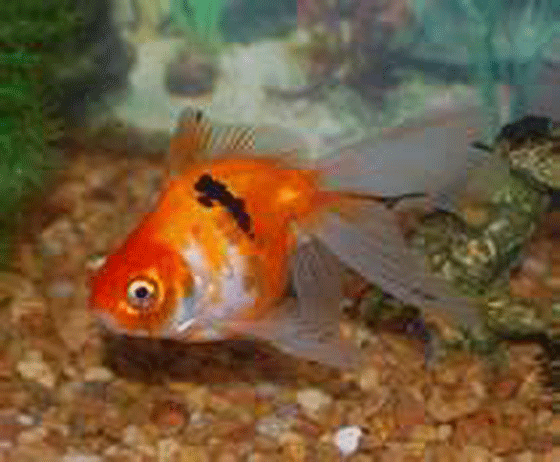How do you know when your fish is sick? You’ll notice unusual behavior or appearance and signs of distress. Watch for indicators to pinpoint the problem.
The good news is that often the cause can be treated quite easily once you’ve figured out what the issue is. Acting quickly is the key to give your fish the best chance of recovery.
Gasping for air
What to Look For: Sick goldfish may often struggle to take in enough oxygen.
Fortunately it’s pretty easy to tell if your goldfish are gasping for air as they’ll usually stay around the surface, gulping down bubbles, or will swim in jerky patterns with their mouth open.
Cause: The good news is that gasping for air usually isn’t a sign of anything sinister, and it’s more often a symptom of stress. Stress itself isn’t dangerous for a goldfish, but it can reduce the efficiency of the immune system and leave your fish susceptible to disease.
Treatment: Look for common stress triggers in your tank that may be making your goldfish sick. This includes unsuitable water temperature (keep it between 23 and 24 degrees celsius), inadequate cleanliness of the tank, overcrowding, even undercrowding, and install an air pump and oxygenate the water.
Unusual swimming motions
What to Look For: Healthy goldfish will normally swim in an upright position, and will naturally position themselves nearer to the bottom of the tank. This is because it’s instinct to protect themselves from predators. Sick goldfish, however, may swim sideways, tilted at a 45 degree angle, or can stay at the top of the tank. This is a sign that they’re unable to sink to the bottom.
Cause: Swim Bladder Disease is the most common reason for unusual swimming motions, although there are numerous other causes of the condition, including stress, parasites, or digestive problems.
Digestive problems are the most common cause of Swim Bladder Disease, as the swim bladder is connected to the digestive tract.
Try soaking dried food to soften it before feeding to reduce bloating, or give your sick goldfish daphnia which acts as a natural laxative.
Visible skin issues
What to Look For: Sick goldfish may show a number of physical symptoms of disease, such as open wounds which can be white, pink, or red in color, a tightening of the skin which can suggest swelling, small spots that can be white or gold-like in color, frayed or ragged fins, or visible lumps or growths on the gills.
Cause: There are multiple causes of skin complaints in fish, so diagnosing sick goldfish through visible signs can be tricky. Small spots are likely to be parasites, perhaps Ich, while open wounds could be the sign of ulcers. Tightened skin could suggest Dropsy, while damaged fins are often a sign of Fin Rot, or of a bacterial infection.
Treatment: Skin issues can usually be treated in one of 3 ways depending on the cause. Anti-fungal medications, anti-bacterial medications, or heat treatments for parasites.
Unusual eye appearance
What to Look For: Your goldfish may appear to have protruding, bulging eyes when sick which are very obvious to owners, but symptoms could also be much more subtle.
Keep a look out for excessive mucous build ups on and around the eye, or a cloudy film covering the eye. It can be difficult to see these symptoms.
Cause: Differences in the eye appearance of goldfish usually happen for one of 2 reasons. Exophthalmos of the eye, or ‘Pop Eye’ as it’s commonly known, is a swelling of the eye, and is usually caused by an infection.
Cloudy Eye, on the other hand, which may or may not be accompanied by swelling, is usually a sign of a vitamin deficiency.
Treatment:
- Goldfish that have been diagnosed with Pop Eye should be quarantined and treated with antibiotic medications prescribed by a fish veterinarian.
- Cloudy Eye can usually be rectified with a change in diet to include more vitamins, such as incorporating live food for example, or may even clear up with a change of water and better tank cleanliness.
Fish is refusing to eat
What to Look For: Sometimes diagnosing sick goldfish can be similar to people, and a sudden loss of appetite is usually one of the first signs that something is wrong. Keep an eye out for food flakes that remain uneaten and are left to rot, and for sick fish who might not swim to the surface at feeding times.
Cause: A refusal to eat can be caused by something as simple as a small amount of stress because of a change in water, for example. But it could also be a sign of something more serious. Unfortunately diagnosing fish who aren’t eating can be difficult but it’s often a sign of ammonia toxicity. Too much ammonia for the size of the tank.
Treatment: If you have diagnosed ammonia toxicity, move your fish to a larger tank and install a heavy filtration system to ensure the water is kept clean. Properly oxygenated water is a necessity for your goldfish to grow bigger and live longer.
Indications there's a problem with the fish tank water
Treatments for aquarium water
If your fish is acting in an unusual way or in obvious distress, fixing water issues could be the solution. These tables list symptoms that you’ll notice either alone or in conjunction with some other indicators. Possible water treatments you might want to try are listed.
![]() A word of caution, some issues can be serious and other treatments may be necessary.
A word of caution, some issues can be serious and other treatments may be necessary.
Fish tilts to one side
What you might also notice
- The goldfish is upside down at the bottom of the tank
- Seems too weak to swim
- Unconscious and appears to be dying
- Has little or no response
* It’s unknown what might be wrong with the goldfish, but if the above symptoms are seen simultaneously, the goldfish is obviously in distress and needs some help.
How to treat the water
- Find 3 containers.
- Fill container 1 with 2 gallons of the coldest tap water you can find.
- Add water treatment to remove ammonia, chloramines, and chlorine from the water.
- In container 2, dissolve 1 tablespoon of salt per gallon of water you will use.
- Add ¼ teaspoon of baking soda into container 2.
- Fill container 3 with 1 gallon of water from container 1 and all the contents of container 2 together.
- With clean, cupped hands, scoop the sick goldfish into container 3 along with 1 gallon of water from the original tank.
- Using the water in container 1, perform multiple water exchanges with container 2 until most of the water has been exchanged.
- If the goldfish doesn’t move around on its own, help it move in a forward movement, never backwards.
- Gently massage the underside of the goldfish.
- Raise its head out of the water and gently blow on its face. This might make the fish open up its mouth and gasp for air. This will help the fish breathe.
- Pour water from container 1 into container 3 from a high distance, disrupting the surface of the water as much as possible. This, too, will help the fish breathe.
Repeat steps 9 – 12 until the fish moves on its own.
Goldfish sits at the bottom of the tank or pond
You may also notice
- The goldfish is swimming in somersaults or in circles
- Has no appetite and not eating
- Appears curled in a bent position, folded over, or crooked
- Has spasms or is twitchy
** If goldfish appear to have this set of symptoms, a likely cause is a high level of nitrates in the water. Nitrates reduce oxygen supply to the goldfish’s tissue and blood stream. This condition is called Methemoglobinemia.
How to treat the water
- Perform frequent, small water changes, adding new water in small batches to reduce further injury to the goldfish.
- Continue to monitor the behavior of goldfish. If the fish doesn’t change behavior, administer the Green Tea treatment to see if that will help.
Green Tea Treatment
If goldfish are suffering from nitrate poisoning, they may benefit from this treatment which includes the use of caffeine to give them a ‘jump start’ by increasing their heart rates.
- Boil 1 cup of water.
- Pour water over 6 small or one large green teabag(s). Make sure the tea is caffeinated. Steep until water reaches room temperature.
- Change out 5% of the cooled tea with fresh water and add it to the tank.
- Continue to change out 5% of the water each day for the next 3 days.
So you can avoid elevated nitrate levels in the future, it’s important to change out water frequently or encourage algae/plant growth. Plants and algae feed on nitrates, providing a nice balance for the goldfish.
Blowing bubbles from rapidly moving gills
Other indicators
- Goldfish is gasping at the surface of the water
- Bleeding from eye (s) Bulging eye(s) – and it’s not a type of telescope goldfish
* If goldfish appear to have this set of symptoms, there’s a good chance they’re suffering from Oxygen Deprivation.
How to treat the water
- Check to make sure pH levels in the water are between 7 and 8.
- Find an empty container that’s free of contaminants and fill it with fresh tap water, to the capacity that will be changed out of the existing tank or pond.
- Find a second empty container and pour the water back and forth several times. This will eliminate supersaturated gasses in the tap water.
- If available, treat the fresh water with conditioners that will remove chlorine and chloramines.
- Add baking soda to the conditioned water at the ratio of 1 teaspoon per10 gallons. Note: Don’t do this if your pH level is over 7.5.
- Add sea salt, kosher salt, aquarium salt, or Morton’s pure rock salt to the conditioned water at the ratio of 1 teaspoon per 10 gallons. Note: Don’t do this if fish has raised scales or is bloated.
- Optionally, add Epsom salt to the conditioned water at the ratio of 1 tablespoon per 10 gallons.
- Change out 50% of the old water with the newly conditioned batch by adding 5% every 15 minutes. Don’t change out all 50% at once.
- Continue this method, changing out 20% of the water each day until the situation improves.
Pouring water from a distance into the fish tank or pond will also increase oxygen levels. This can be done by pouring, slowly, from a distance, creating ripples and surface activity. This process can be repeated every 15 minutes until oxygen levels are optimized.
Fish is swimming at a 45 degree angle
You might also notice
- Fish is floating at or near the surface
- Bobbing up and down
- Floating upside down at the top of the tank or pond
- Swimming at a 45 degree angle or can’t swim at all
- Sporadic or uncontrolled swimming
** If goldfish appear to have this set of symptoms, it’s quite likely they are suffering from a swim bladder issue. This could be a result of infection, poisoning, or impacted eggs. This is extremely uncomfortable for the goldfish.
What to do with the water
Swim bladder issues are generally prevalent in goldfish that live in tall, narrow tanks with a limited surface area. If this is the case the pressure of the water in a deep, narrow tank is the problem.
- Gradually decrease the level of water in the fish tank.
- Check the goldfish in a few hours. It should improve by then.
- Keep the depth of the tank low for a few months and gradually increase the depth one inch at a time.
- If the goldfish doesn’t improve, it may be suffering from a bacterial infection. If that’s the case, provide goldfish with smaller meals to avoid constipation.
Goldfish has raised scales
Other signs you might notice
- Pine coning (scales)
- Goldfish has diminished appetite
* If your goldfish appear to have this set of symptoms, they’re possibly living in water that’s too hot for them. Goldfish have no core body temperature and are not able to regulate themselves and adjust for varying water temps. Their body temperatures can also increase due to infections. If these symptoms are not taken care of, the goldfish can end up with organ failure.
How you can treat the water
- Change out water a little bit at a time until 60% of it has cycled through, reducing the temperature of the water to 55 or 60 degrees f. Colder water or ice cubes could help.
- Get a ¼ cup of warm water.
- Add Epsom salt to the warm water at a ratio of 1 tablespoon per 10 gallons.
- Add baking soda to the warm water at a ratio of ¼ teaspoon per 10 gallons.
- Dilute the solution in a larger container of water before putting it in the main tank.
- Continue to change out the water over time.
Should I self-diagnose a sick goldfish?
One of the benefits of owning goldfish over other types of fish is that they’re incredibly hardy and rarely become sick as long as they’re kept in an environment that suits their needs.
What’s even better is that if goldfish do become sick the more common goldfish diseases aren’t killers, and can often be treated successfully at home.
This begs the question: ‘Is diagnosing sick goldfish at home a good idea, or is it better to get a professional opinion?’ Unfortunately it’s often difficult to tell what’s wrong with a goldfish (if only they could talk!), but some diseases are more obvious than others. If you’re in any doubt, always chat with your veterinarian. They’ll be able to suggest the best course of action for your sick fish.
You may also like
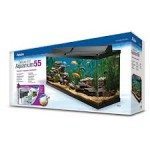 Review of One of the Best Small Aquarium Filters
Review of One of the Best Small Aquarium Filters What are Wild Blue Green Algae? Are There Any Benefits?
What are Wild Blue Green Algae? Are There Any Benefits?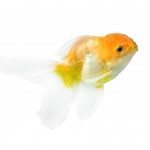 Dropsy – How To Diagnose And Cure Goldfish Of This Disease
Dropsy – How To Diagnose And Cure Goldfish Of This Disease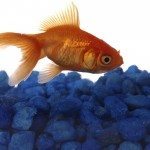 Aquarium Accessories Product Review : Aqueon Water Changer
Aquarium Accessories Product Review : Aqueon Water Changer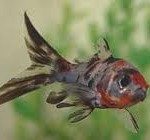 Shubunkin Goldfish: Discover How Easy It Is To Have As A Pet
Shubunkin Goldfish: Discover How Easy It Is To Have As A Pet What is the Perfect Goldfish Water Temperature?
What is the Perfect Goldfish Water Temperature?

